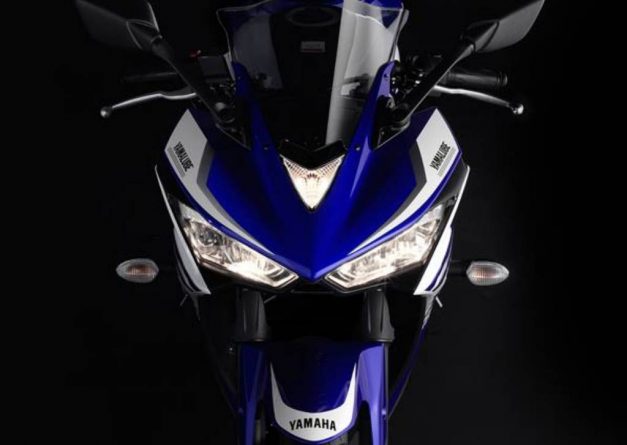Hurray everyone! The Yamaha R25 has been finally launched in Indonesia. This is the first time ever a concept was turned into a production model so soon. The R25 is here with a twin-cylinder engine producing 36 PS of power and 22 Nm of torque. With a kerb weight of 166 kgs, it is 6 kgs lighter than its chief competitor, the Kawasaki Ninja 300 but the green machine has more cubic capacity, more torque and more power too. The R25 is aimed against the Ninja 300 in many ways and the Honda CBR300R can simply not match it.
When we start considering the facts, the Yamaha R25 has the same type of chassis, suspension, tyres as few bikes in the segment (Honda CBR300R and Kawasaki Ninja 300). Yamaha seems to be so impressed with their latest offering that they are proudly calling it the baby “M1”. Baby M1? Are you serious? A bike which does not have a perimeter frame, no pro-link suspension, no aluminium swing arm, no upside down forks is being called as a MotoGP inspired motorcycle, we think that is clearly a wrong tag. The R15 has most of the above mentioned stuff. Upside down forks and perimeter frame come on the R125 in Europe, why isn’t the baby “M1” having all of this?
We are not criticising the product because we know it is still going to handle and perform exceptionally well but the name which is being given to it is wrong. Baby “M1” “YZF” is not the right tags given to the R25. Truss-diamond frames found on the CBR and Ninja are dated when compared to perimeter or trellis frames. However, there is no doubt they do make the motorcycle handle almost similarly as the latter equipped motorcycles but there will be a difference when it comes to feedback, confidence and end results.
Kawasaki had made a similar mistake by putting an R tag on the 250 and 650, removing it in an update, despite improving them by leaps and bounds. Honda did it with the styling of the CBR by making it look like the VFR and changed it in the next upgrade. How can Yamaha do it? Don’t manufacturers learn from each others mistakes? Or simply, Yamaha is trying to leverage the brand name and target immature Asian audience?
Yes, yes we understand if all the above equipment was on the baby M1 then the prices would almost double. However, was there a need of a twin-cylinder? Yes, the twin-cylinder is a major factor of the pricing. The Ninja 300 is also attacked due to the same reasons. In this high tech age, was it not possible to make a 250cc engine with a single-cylinder configuration, putting 30 odd horsepower on tap? We think we have an answer to that from our domestic and largest selling manufacturer in the world, Hero MotoCorp, the HX250R with 31 PS and 26 Nm of torque. Honda has come up with a 286cc, 30.4 PS, 27 Nm engined bike in the form of the CBR300R. These motorcycles use single-cylinder engines too. Let us not forget that the 373.2cc, KTM Duke 390 with the kind of power and torque figures it has, is above the moon when compared to the R25.
Now enthusiasts and fans would argue that twin-cylinder refinement is far more superior. Sure, agreed, but how much money does it take to make one? Japanese have been making high capacity in-line four-cylinder motorcycles cheaper when you compare to today’s twin-cylinder quarter-litre motorcycles. We also agree to the fact that the lower you go, you have to pay a price but after all the cost is on the lower side too, right? Japanese have been making in-line four quarter-litre motorcycles in the olden times and still they were priced well when you consider European pricing.
All we ask is why this overhaul-type of loot from Japanese manufacturers. No where in our minds are we comparing it to KTM-Bajaj, TVS or Hero. We know Indian and Europeans provide certain value as always from their motorcycles and they are not way behind in terms of refinement and quality. Our point is that the price gap is way too high.
We are still hoping for a good price tag here in India and may be an inclusion of ABS, at least as an option. The 250cc offering from Yamaha could have been better in the form of the FZ250 rather than in the current “YZF baby M1” form. All this chassis and equipment on the FZ would have suited endlessly to this package and a semi-faired version would have rocked the world. Expecting the FZ form also is not a bad dream either. However, Yamaha chose the other way and we just hope that we are not left disappointed by bounded traditions and old school techniques. Think about it with an open-cold mind and do let us know what you think about the situation.

